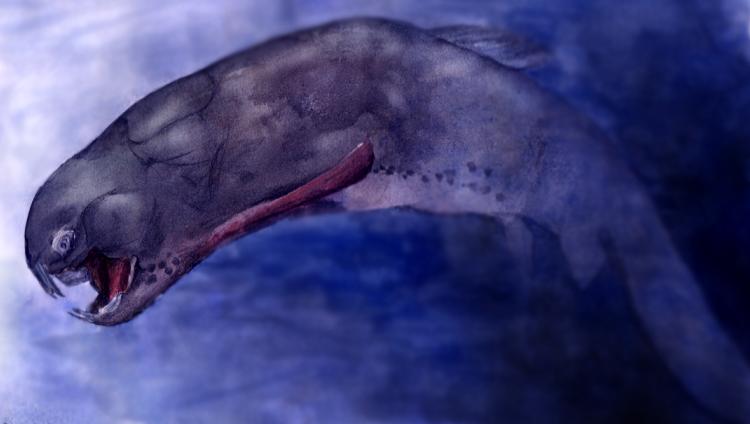|
| Query: fish | Result: 1515th of 13203 | |
Dunkleosteus - Wiki
| Subject: | Dunkleosteus - Wiki
| |

| Resolution: 750x424
File Size: 27761 Bytes
Upload Date: 2006:11:29 10:10:40
|
Dunkleosteus
From Wikipedia, the free encyclopedia
[Photo] Description: Life reconstruction of Dunkleosteus, a Devonian Placoderm and member of the Arthrodira. de: Lebendrekonstruktion von Dunkleosteus, einem devonischen Panzerfisch aus der Gruppe der Arthrodira. Source: www.dinosauromorpha.de, Author: Frederik Spindler
Dunkleosteus was a large placoderm that lived in the late Devonian period, about 370 ??? 360 million years ago. It grew to around 8 to 10 metres (27 to 33 feet) long, and was probably the top predator of its time.
Dunkleosteus belongs to the Placodermi, a Class of armor-plated fishes. Dunkelosteus was probably the largest member of this family. The Placodermi first started appearing in the Silurian, and all of them were extinct by the late Devonian. There are no modern descendants.
Due to its heavily armoured nature, Dunkleosteus was likely a relatively slow (albeit massively powerful) swimmer, and may have encountered stiff competition from the smaller yet swifter sharks who had then only recently evolved. It is presumed to have dwelled primarily in diversal zones, although it is unknown whether or not it was also somewhat pelagic. Fossilization tends to have only preserved the especially armoured frontal sections of specimens, and this creates uncertainty as to what exactly the hind sections of this ancient fish were like.
By Devonian standards, Dunkleosteus was highly evolved. It was one of the earliest jawed fishes. Instead of actual teeth, Dunkleosteus possessed two long, bony blades that could slice through flesh and snap and crush bones and almost anything else. It was a vicious hunter, and probably ate whatever it could find, including sharks and probably other Dunkleosteus. It was a glutton, as well. Frequently, fossils of Dunkleosteus are found with semi-digested and partially eaten remains of other fish. As a result, the fossil record indicates that it either suffered from acute indigestion, or that it routinely regurgitated prey bones rather than dissolving them. Dunkleosteus, like most other placoderms, may have also been among the first vertebrates to internalize egg fertilization, and thus sexually reproduce in the manner that most mammals and sharks do today.
Although Placoderms only existed for 60 million years, their mark on the fossil record is quite visible. They were a pioneer in the later scenes of the Paleozoic, and were vital to the success of the vertebrates. The Placoderms died out in the late Devonian for reasons that are still not well understood. See Late Devonian extinction.
They were found in Morocco, Belgium, Poland, and North America.
| The text in this page is based on the copyrighted Wikipedia article shown in above URL. It is used under the GNU Free Documentation License. You may redistribute it, verbatim or modified, providing that you comply with the terms of the GFDL. |
|
Comments |
|---|
| | Black Guy |
|
| How long did the Dunkleosteus exist exactly? |
^o^
Animal Pictures Archive for smart phones
^o^
|
|
|